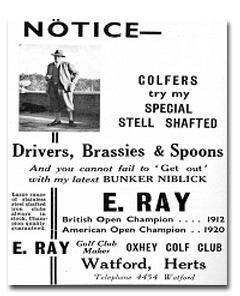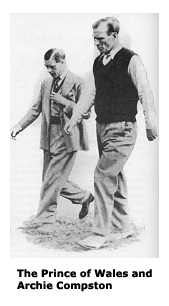|

Captaining the England team was former Open and US Open
champion, Ted Ray, then in his mid sixties. Just as in his
tournament playing days he was rarely seen without his battered felt
hat and a pipe clenched between his teeth. He was pro at Oxhey Golf
Club from 1912 until 1941.
St Andrews was parched that year, with brown fairways on which the
ball seemed to roll forever. In qualifying, on the par-4 12th with
its bottleneck green, Arthur Lacey, who had made his Ryder Cup debut
at Southport & Ainsdale, drove to the foot of the slope below the
putting surface. His first putt came back to his feet, then he went
over the back and, after further toing and froing his high hopes of
a birdie had turned into a nightmare eight. He picked up and made no
return.
 The Prince of Wales was at St Andrews that week and he joined the
gallery to watch the first round match of Henry Cotton and Archie
Compston, who was pro at the famous Coombe Hill club where the
Prince was a member. Archie was five under fours on the 15th tee,
but when Prince Edward appeared he began playing to the gallery even
asking a small boy to advise him on the choice of club for his
second. He fluffed the shot into a bunker and went on to finish with
a 72 before making a furious exit from the last green. The Prince
attracted a great deal of attention as he had when he attended the
Ryder Cup and presented the trophy to the British captain J. H. Taylor.
150,000 went to watch at Southport and Ainsdale, many of whom had
more interest in the Prince than the golf, but that summer the
11-handicapper played in the final of the Parliamentary Handicap at
Coombe Hill, almost un-noticed. Only four people followed his match,
which he lost 5 & 4 to the 67-year-old Liberal M. P., George Lambert
(14). The Prince of Wales was at St Andrews that week and he joined the
gallery to watch the first round match of Henry Cotton and Archie
Compston, who was pro at the famous Coombe Hill club where the
Prince was a member. Archie was five under fours on the 15th tee,
but when Prince Edward appeared he began playing to the gallery even
asking a small boy to advise him on the choice of club for his
second. He fluffed the shot into a bunker and went on to finish with
a 72 before making a furious exit from the last green. The Prince
attracted a great deal of attention as he had when he attended the
Ryder Cup and presented the trophy to the British captain J. H. Taylor.
150,000 went to watch at Southport and Ainsdale, many of whom had
more interest in the Prince than the golf, but that summer the
11-handicapper played in the final of the Parliamentary Handicap at
Coombe Hill, almost un-noticed. Only four people followed his match,
which he lost 5 & 4 to the 67-year-old Liberal M. P., George Lambert
(14).
In those days the Open Championship finished with two rounds on the
Friday, as most pros had to be back at their clubs for the weekend
to serve their members. I was going fairly well until the last
round, when it really started to blow. Two things happened in that
final round, which are indelibly imprinted on my memory. The gale
was helping on the outward holes and at the 2nd my drive finished
just short of the green, but here it was my turn to suffer. I played
a pitch and run shot, which hit the green and ran on and on,
finishing on the far side of the double green, which the hole shares
with the16th. I was 60 yards from the pin, further away from the
target than my drive had been, and I took four more to get down.
Those of you who have played the Old Course will know how daunting
it is to be faced with a 60-yard putt. The rules don’t demand the
use of a putter of course and you can understand why many years
later American Mark Calcavecchia, when facing a similar shot,
decided to chip, but it did not go down too well with the
authorities.
The second incident occurred at the 13th, coming back against the
‘sandstorm’. In the morning I had used a spade-mashie (six iron) for
my second; in the afternoon it was a spoon (three wood), which found
the double green but was a long way from the hole – 43 yards in
fact. The reason I know the exact length was that I paced it out
after it dropped into the cup. It was the longest putt I ever holed.
The round was completed in 80 strokes and I was one of twenty-five
out of the fifty-eight players who did not break 80 in that wind
blown final round. Another was Walter Hagen, who had opened with a
68 and added a 72 to lead the field, but finished with an 82 to join
me in a share of twenty-second place on 301.In only my second Open I
felt that was not too bad, given the circumstances. Our prize was
£10, which was pin money for Walter. On his annual trips to Europe
golf’s first superstar was spending over $10,000, by the time he had
paid his travel expenses and the bill at London’s Savoy Hotel for
himself and his retinue. (When staying at the Savoy he practised on
the roof, hitting balls into the Thames). Then there was the hire
charge for his Rolls-Royce, which doubled as transport and mobile
changing room – if they expected him to change in the car park he
would do it in style. He famously said that he did not want to be a
millionaire – “just to live like one”. That he certainly did! 1933
was his last hurrah in his favourite championship. “If I can have
that one the others can have all the rest”, he said.
Walter did as much as anyone for trans-Atlantic relations; As
American Ryder Cup Captain that year he led all the American players
to the St Andrews Cathedral grounds, where he laid wreaths on the
graves of Old and Young Tom Morris. Amongst them was Densmore Shute,
the son of a Royal North Devon golfer who went to America to become
a professional.
NEXT |


 The Prince of Wales was at St Andrews that week and he joined the
gallery to watch the first round match of Henry Cotton and Archie
Compston, who was pro at the famous Coombe Hill club where the
Prince was a member. Archie was five under fours on the 15th tee,
but when Prince Edward appeared he began playing to the gallery even
asking a small boy to advise him on the choice of club for his
second. He fluffed the shot into a bunker and went on to finish with
a 72 before making a furious exit from the last green. The Prince
attracted a great deal of attention as he had when he attended the
Ryder Cup and presented the trophy to the British captain J. H. Taylor.
150,000 went to watch at Southport and Ainsdale, many of whom had
more interest in the Prince than the golf, but that summer the
11-handicapper played in the final of the Parliamentary Handicap at
Coombe Hill, almost un-noticed. Only four people followed his match,
which he lost 5 & 4 to the 67-year-old Liberal M. P., George Lambert
(14).
The Prince of Wales was at St Andrews that week and he joined the
gallery to watch the first round match of Henry Cotton and Archie
Compston, who was pro at the famous Coombe Hill club where the
Prince was a member. Archie was five under fours on the 15th tee,
but when Prince Edward appeared he began playing to the gallery even
asking a small boy to advise him on the choice of club for his
second. He fluffed the shot into a bunker and went on to finish with
a 72 before making a furious exit from the last green. The Prince
attracted a great deal of attention as he had when he attended the
Ryder Cup and presented the trophy to the British captain J. H. Taylor.
150,000 went to watch at Southport and Ainsdale, many of whom had
more interest in the Prince than the golf, but that summer the
11-handicapper played in the final of the Parliamentary Handicap at
Coombe Hill, almost un-noticed. Only four people followed his match,
which he lost 5 & 4 to the 67-year-old Liberal M. P., George Lambert
(14).